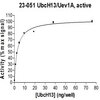| Xiaochun Ge, et al. (2007) AtNUDT7, a negative regulator of basal immunity in Arabidopsis, modulates two distinct defense response pathways and is involved in maintaining redox homeostasis. Plant Physiology 145, 204-215.
John D. Kulman, et al. (2007) Proline-rich Gla protein 2 is a cell-surface vitamin K-dependent protein that binds to the transcriptional coactivator Yes-associated protein. Procedings of the National Academy of Science 104, 8767-8772.
Hua A. J. Lu, et al. (2007) Heat shock protein 70 interacts with aquaporin-2 and regulates its trafficking. Journal of Biological Chemistry 282, 28721-28732.
Johnna L. Roose, Yasuhiro Kashino and Himadri B. Pakrasi. (2007) The PsbQ protein defines cyanobacterial photosystem II complexes with highest activity and stability. Procedings of the National Academy of Science 104, 2548-2553.
Keiko Yonekura-Sakakibara, et al. (2007) Identification of a flavonol 7-O-rhamnosyltransferase gene determining flavonoid pattern in Arabidopsis by transcriptome coexpression analysis and reverse genetics. Journal of Biological Chemistry 282, 14932-14941.
Hendrik Adams, et al. (2006) Interaction of tonB with the outer membrane receptor FpvA of Pseudomonas aeruginosa. Journal of Bacteriology 188, 5752-5761.
Alyssa Carré-Mlouka, et al. (2006) A new rubisco-like protein coexists with a photosynthetic rubisco in the planktonic cyanobacteria Microcystis. Journal of Biological Chemistry 281, 24462-24471.
Athanasios Michos, et al. (2006) Enhancement of streptolysin O activity and intrinsic cytotoxic effects of the group A streptococcal toxin, NAD-glycohydrolase. Journal of Biological Chemistry 281, 8216-8223.
Eric A. Schmelz, et al. (2006) Fragments of ATP synthase mediate plant perception of insect attack. Proceedings of the National Academy of Sciences (USA) 103, 8894-8899.
Jerome Vicogne, et al. (2006) Asymmetric phospholipid distribution drives in vitro reconstituted SNARE-dependent membrane fusion. Procedings of the National Academy of Science 103, 14761-14766.
Peter T. Beernink, et al. (2005) Specificity of protein interactions mediated by BRCT domains of the XRCC1 DNA repair protein. Journal of Biological Chemistry 280, 30206-30213.
Padmanabhan Chellappan, Ramachandran Vanitharani and Claude M. Fauquet. (2005) MicroRNA-binding viral protein interferes with Arabidopsis development. Proceedings of the National Academy of Sciences (USA) 102, 10381-10386.
Pierre Fotso, et al. (2005) Cog1p plays a central role in the organization of the yeast conserved oligomeric golgi (COG) complex. Journal of Biological Chemistry 280, 27613-27623.
Laigeng Li, et al. (2005) Clarification of cinnamoyl co-enzyme a reductase catalysis in monolignol biosynthesis of aspen. Plant and Cell Physiology 46, 1073-1082.
Carole M. Liedtke, Xiangyun Wang and Nicole D. Smallwood. (2005) Role for protein phosphatase 2A in the regulation of calu-3 epithelial Na+-K+-2Cl-, type 1 co-transport function. Journal of Biological Chemistry 280, 25491-25498.
Kenneth L. Madsen, et al. (2005) Molecular determinants for the complex binding specificity of the PDZ domain in PICK 1. Journal of Biological Chemistry 280, 20539-20548.
Sandeep Kumar Srivastava, Rama Pati Tripathi and Ravishankar Ramachandran. (2005) NAD+-dependent DNA ligase (Rv3014c) from M. tuberculosis: crystal structure of the adenylation domain and identification of novel inhibitors. Journal of Biological Chemistry 280, 30273-30281.
Victor J. Torres, et al. (2005) Functional properties of the p33 and p55 domains of the Helicobacter pylori vacuolating cytotoxin. Journal of Biological Chemistry 280, 21107-21114.
Tobias S. Ulmer, et al. (2005) Structure and dynamics of micelle-bound human α-synuclein. Journal of Biological Chemistry 280, 9595-9603.
Tobias S. Ulmer and Ad Bax. (2005) Comparison of structure and dynamics of micelle-bound human -synuclein and Parkinson's disease variants. Journal of Biological Chemistry 280, 43179-43187.
Hsin-ya Yang, Paul E. Mains and Francis J. McNally. (2005) Kinesin-1 mediates translocation of the meiotic spindle to the oocyte cortex through KCA-1, a novel cargo adapter. Journal of Cell Biology 169, 447-457.
Calvin K. Yip, et al. (2005) Structural characterization of the molecular platform for type III secretion system assembly. 435, 702-707.
Xiangang Zong, et al. (2005) A novel mechanism of modulation of hyperpolarization-activated cyclic nucleotide-gated channels by SRC kinase. Journal of Biological Chemistry 280, 34224-34232.
Heinz C. Schroeder, et al. (2003) Emergence and disappearance of an immune molecule, an antimicribioal lectin, in basal metazoa. Journal of Biological Chemistry 278, 32810-32817.
|
|














